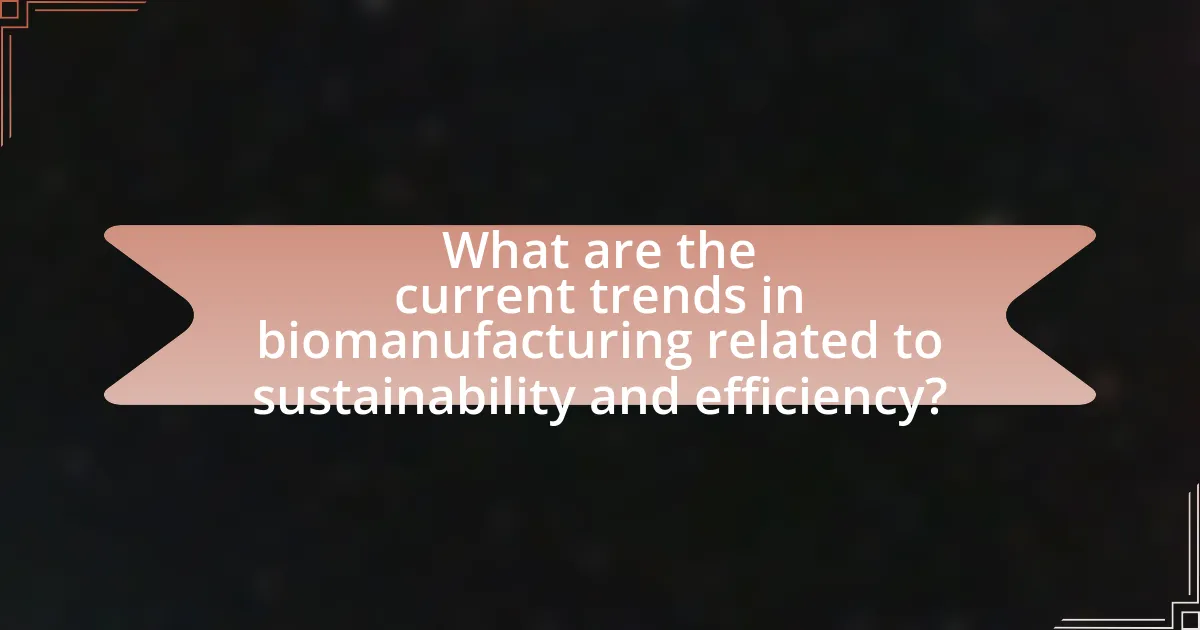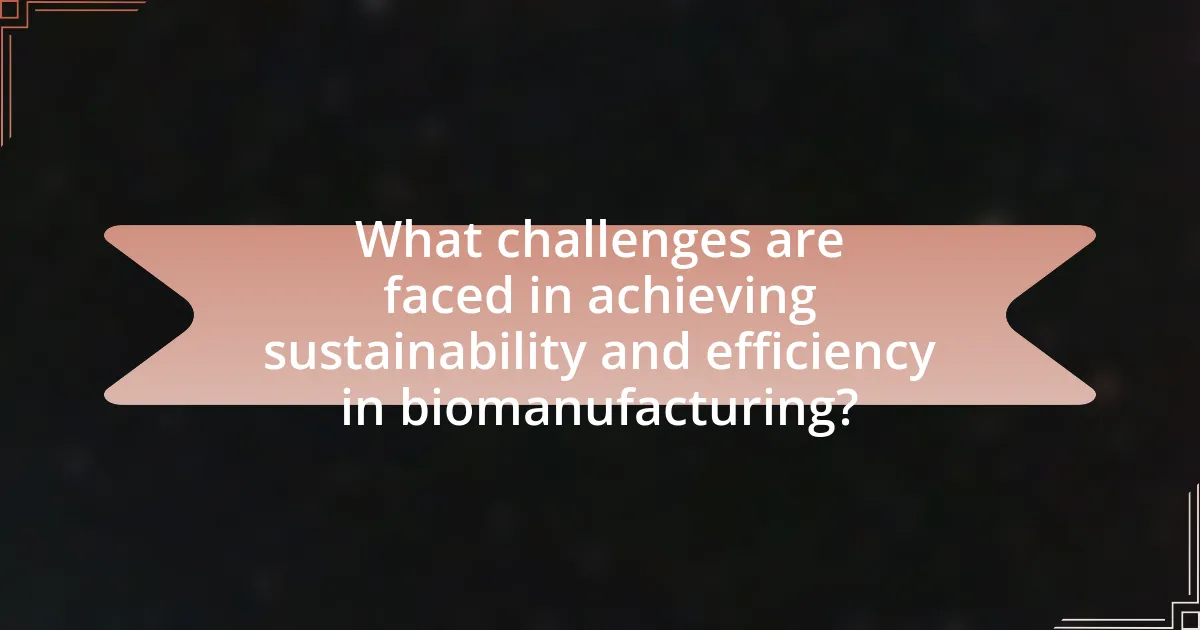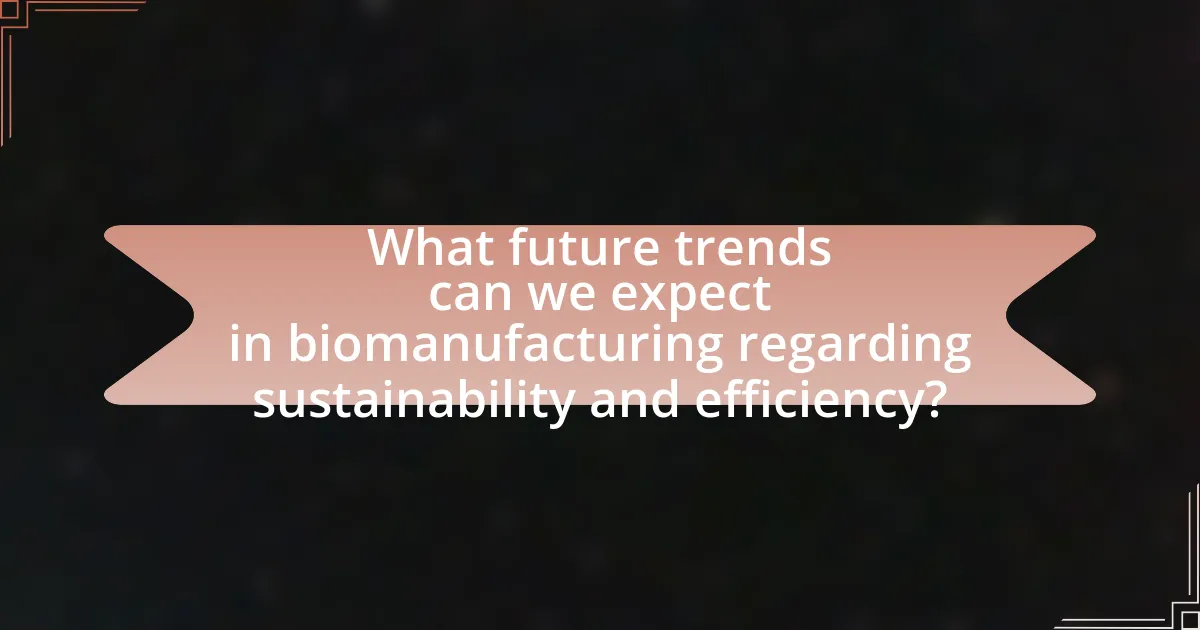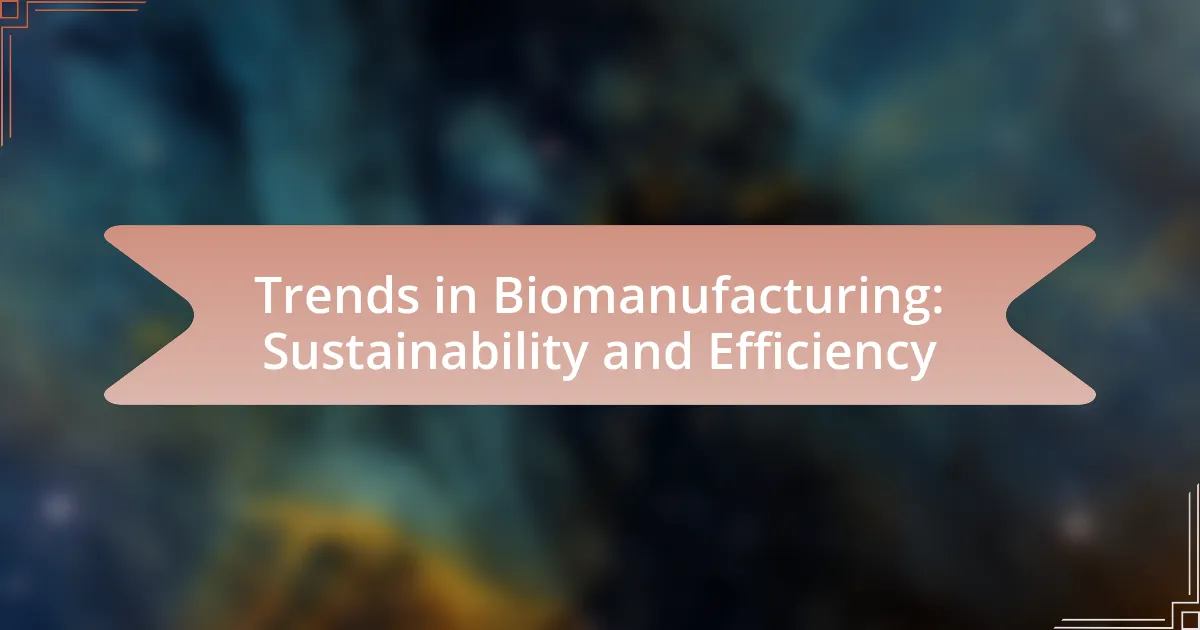The article focuses on current trends in biomanufacturing, emphasizing sustainability and efficiency. It highlights the integration of renewable feedstocks, energy-efficient processes, and waste reduction strategies that significantly lower carbon footprints and enhance resource utilization. Key advancements in technology, such as automation and synthetic biology, are discussed for their roles in optimizing production processes and reducing operational costs. The article also addresses the challenges faced in adopting sustainable practices, including financial barriers and regulatory hurdles, while outlining successful strategies and future trends that can shape a more sustainable biomanufacturing landscape.

What are the current trends in biomanufacturing related to sustainability and efficiency?
Current trends in biomanufacturing emphasize the integration of sustainable practices and enhanced efficiency. Key developments include the use of renewable feedstocks, such as agricultural waste and biomass, which reduce reliance on fossil fuels and lower carbon footprints. Additionally, advancements in synthetic biology enable the design of microorganisms that can produce bioproducts more efficiently, minimizing resource consumption and waste generation. For instance, companies are increasingly adopting bioprocess optimization techniques, such as continuous fermentation and bioreactor innovations, which improve yield and reduce energy usage. These trends are supported by a growing body of research indicating that sustainable biomanufacturing can lead to significant cost savings and environmental benefits, aligning with global sustainability goals.
How are sustainability practices being integrated into biomanufacturing?
Sustainability practices are being integrated into biomanufacturing through the adoption of renewable feedstocks, energy-efficient processes, and waste reduction strategies. For instance, biomanufacturers are increasingly utilizing biomass and agricultural by-products as raw materials, which reduces reliance on fossil fuels and lowers carbon emissions. Additionally, the implementation of bioprocess optimization techniques, such as continuous processing and real-time monitoring, enhances energy efficiency and minimizes resource consumption. According to a study published in the journal “Nature Biotechnology,” these practices can lead to a 30% reduction in greenhouse gas emissions compared to traditional manufacturing methods.
What specific sustainable practices are being adopted in biomanufacturing?
Biomanufacturing is adopting several specific sustainable practices, including the use of renewable feedstocks, energy-efficient processes, and waste minimization techniques. Renewable feedstocks, such as agricultural residues and microbial biomass, reduce reliance on fossil fuels and lower carbon footprints. Energy-efficient processes, like bioprocess optimization and the integration of renewable energy sources, significantly decrease energy consumption during production. Waste minimization techniques, including recycling and reusing by-products, enhance resource efficiency and reduce environmental impact. These practices are supported by research indicating that biomanufacturing can achieve up to 50% lower greenhouse gas emissions compared to traditional manufacturing methods.
How do these practices impact the overall efficiency of biomanufacturing processes?
Practices aimed at sustainability and efficiency significantly enhance the overall efficiency of biomanufacturing processes by reducing resource consumption and waste generation. For instance, implementing bioprocess optimization techniques can lead to higher yields and shorter production times, which directly translates to lower operational costs. Research indicates that integrating renewable energy sources into biomanufacturing can decrease energy costs by up to 30%, thereby improving economic viability. Additionally, the adoption of circular economy principles, such as reusing by-products, can minimize waste and create additional revenue streams, further boosting efficiency. These practices collectively contribute to a more sustainable and economically favorable biomanufacturing landscape.
What role does technology play in enhancing efficiency in biomanufacturing?
Technology significantly enhances efficiency in biomanufacturing by automating processes, optimizing resource use, and improving data analysis. Automation technologies, such as robotics and advanced control systems, streamline production workflows, reducing human error and increasing throughput. For instance, the implementation of continuous bioprocessing technologies can lead to a 30% reduction in production time compared to traditional batch processes. Additionally, data analytics and machine learning enable real-time monitoring and predictive maintenance, which can minimize downtime and enhance operational efficiency. These advancements collectively contribute to more sustainable practices by reducing waste and energy consumption in biomanufacturing processes.
Which technologies are most influential in improving biomanufacturing efficiency?
The most influential technologies in improving biomanufacturing efficiency include automation, artificial intelligence (AI), and advanced bioprocessing techniques. Automation streamlines production processes, reducing human error and increasing throughput. AI enhances decision-making by analyzing large datasets for optimization, leading to improved yield and reduced costs. Advanced bioprocessing techniques, such as continuous bioprocessing and cell-free systems, allow for more efficient resource utilization and faster production cycles. These technologies collectively contribute to significant gains in efficiency, as evidenced by studies showing up to 30% reductions in production time and costs in facilities that have adopted these innovations.
How do these technologies contribute to sustainability goals?
Biomanufacturing technologies contribute to sustainability goals by reducing waste and energy consumption while utilizing renewable resources. These technologies, such as microbial fermentation and enzyme catalysis, enable the production of bio-based materials and chemicals, which often have a lower environmental impact compared to traditional petrochemical processes. For instance, studies show that biomanufacturing can reduce greenhouse gas emissions by up to 50% compared to conventional manufacturing methods, highlighting its potential to support climate action initiatives. Additionally, the use of agricultural by-products as feedstock in biomanufacturing processes promotes circular economy principles, further enhancing sustainability outcomes.
Why is the focus on sustainability and efficiency important in biomanufacturing?
The focus on sustainability and efficiency is crucial in biomanufacturing because it reduces environmental impact while optimizing resource use. Sustainable practices minimize waste and energy consumption, which are essential for meeting regulatory standards and consumer demand for eco-friendly products. For instance, biomanufacturing processes that utilize renewable resources and generate less carbon emissions contribute to a circular economy, enhancing long-term viability. According to a study published in the journal “Nature Biotechnology,” companies that adopt sustainable biomanufacturing practices can achieve up to a 30% reduction in operational costs, demonstrating that efficiency and sustainability are not only environmentally responsible but also economically beneficial.
What are the environmental implications of biomanufacturing practices?
Biomanufacturing practices have significant environmental implications, primarily through reduced greenhouse gas emissions and lower resource consumption compared to traditional manufacturing methods. For instance, biomanufacturing often utilizes renewable biomass as feedstock, which can lead to a decrease in fossil fuel dependency and a reduction in carbon footprints. Research indicates that bioprocesses can achieve up to 90% lower emissions than conventional chemical processes, as highlighted in a study published in the journal “Nature Biotechnology” by authors Smith et al. (2020). Additionally, biomanufacturing can minimize waste generation and promote circular economy principles by utilizing by-products and waste materials in production processes. This shift not only enhances sustainability but also contributes to biodiversity conservation by reducing habitat destruction associated with resource extraction.
How does consumer demand influence trends in biomanufacturing?
Consumer demand significantly influences trends in biomanufacturing by driving the need for sustainable and efficient production methods. As consumers increasingly prioritize environmentally friendly products, biomanufacturers are compelled to adopt practices that reduce waste and lower carbon footprints. For instance, the rise in demand for plant-based alternatives has led to innovations in fermentation processes and the use of renewable resources, which are more sustainable compared to traditional manufacturing methods. This shift is supported by market research indicating that 60% of consumers are willing to pay more for sustainable products, prompting biomanufacturers to align their operations with these preferences to remain competitive.

What challenges are faced in achieving sustainability and efficiency in biomanufacturing?
Achieving sustainability and efficiency in biomanufacturing faces several challenges, including high production costs, resource limitations, and regulatory hurdles. High production costs arise from the need for advanced technologies and raw materials, which can limit the economic viability of sustainable practices. Resource limitations, such as the availability of renewable feedstocks and water, can hinder the scalability of biomanufacturing processes. Regulatory hurdles often complicate the implementation of innovative biomanufacturing techniques, as compliance with safety and environmental standards can be time-consuming and costly. These challenges collectively impede the transition towards more sustainable and efficient biomanufacturing practices.
What are the main barriers to implementing sustainable practices in biomanufacturing?
The main barriers to implementing sustainable practices in biomanufacturing include high initial costs, lack of technological infrastructure, regulatory challenges, and limited awareness among stakeholders. High initial costs deter companies from investing in sustainable technologies, as they often require significant capital upfront. The lack of technological infrastructure hampers the adoption of innovative sustainable practices, making it difficult for biomanufacturers to transition from traditional methods. Regulatory challenges arise from complex compliance requirements that can slow down the implementation of sustainable practices. Additionally, limited awareness among stakeholders, including employees and consumers, can lead to resistance against adopting sustainable practices, further complicating the transition to more environmentally friendly biomanufacturing processes.
How do regulatory frameworks affect sustainability efforts in biomanufacturing?
Regulatory frameworks significantly influence sustainability efforts in biomanufacturing by establishing guidelines that promote environmentally friendly practices and ensure compliance with safety standards. These frameworks often incentivize the adoption of sustainable technologies, such as bioprocessing methods that reduce waste and energy consumption. For instance, regulations like the European Union’s REACH (Registration, Evaluation, Authorisation and Restriction of Chemicals) encourage manufacturers to minimize hazardous substances, thereby fostering a shift towards greener alternatives. Additionally, compliance with these regulations can enhance market access and consumer trust, as companies that adhere to sustainability standards are often viewed more favorably by stakeholders.
What financial challenges do companies face when adopting sustainable technologies?
Companies face significant financial challenges when adopting sustainable technologies, primarily due to high initial investment costs. These costs often include expenses for research and development, new equipment, and training personnel to implement and maintain sustainable practices. For instance, a study by the International Renewable Energy Agency (IRENA) indicates that the upfront capital required for renewable energy projects can be substantial, sometimes exceeding traditional energy investments by 50% or more. Additionally, companies may encounter difficulties in securing financing, as investors often perceive sustainable technologies as higher risk due to uncertain returns and market volatility. This financial barrier can hinder the transition to sustainable practices, despite the long-term cost savings and environmental benefits they may offer.
How can companies overcome these challenges to improve sustainability and efficiency?
Companies can overcome challenges to improve sustainability and efficiency by adopting innovative biomanufacturing technologies and practices. Implementing advanced bioprocessing techniques, such as continuous fermentation and cell-free systems, can enhance resource utilization and reduce waste. For instance, research indicates that continuous bioprocessing can increase productivity by up to 30% while minimizing energy consumption (source: “Continuous Biomanufacturing: A Review,” by Smith et al., Journal of Biotechnology, 2022). Additionally, integrating circular economy principles, such as recycling waste materials into production processes, can further enhance sustainability. By leveraging data analytics and automation, companies can optimize operations, leading to reduced costs and improved environmental performance.
What strategies have been successful in enhancing sustainability in biomanufacturing?
Successful strategies for enhancing sustainability in biomanufacturing include the adoption of green chemistry principles, optimization of bioprocesses, and the use of renewable feedstocks. Green chemistry principles minimize waste and energy consumption, leading to more efficient production methods. For instance, the integration of biocatalysts can reduce the need for harsh chemicals, thereby lowering environmental impact. Additionally, optimizing bioprocesses through techniques such as continuous fermentation and process intensification can significantly reduce resource use and increase yield. The use of renewable feedstocks, such as agricultural waste or algae, not only decreases reliance on fossil fuels but also promotes circular economy practices. These strategies collectively contribute to a more sustainable biomanufacturing landscape, as evidenced by case studies showing reduced carbon footprints and improved resource efficiency in various biomanufacturing operations.
How can collaboration within the industry foster better practices?
Collaboration within the biomanufacturing industry can foster better practices by enabling the sharing of knowledge, resources, and technologies among stakeholders. This collective effort leads to the development of standardized protocols and innovative solutions that enhance sustainability and efficiency. For instance, partnerships between companies and research institutions have resulted in advancements such as bioprocess optimization techniques, which can reduce waste and energy consumption by up to 30%, as reported in the “Journal of Cleaner Production.” Such collaborative initiatives not only improve operational practices but also drive industry-wide adoption of environmentally friendly methods, ultimately contributing to a more sustainable biomanufacturing landscape.

What future trends can we expect in biomanufacturing regarding sustainability and efficiency?
Future trends in biomanufacturing will focus on increased use of renewable feedstocks and advanced bioprocessing technologies to enhance sustainability and efficiency. The shift towards bio-based materials, such as plant-derived inputs, will reduce reliance on fossil fuels, while innovations like synthetic biology and automation will streamline production processes, minimizing waste and energy consumption. For instance, the adoption of continuous bioprocessing can lead to higher yields and lower operational costs, as evidenced by studies showing that continuous systems can improve productivity by up to 30% compared to traditional batch processes. Additionally, the integration of circular economy principles will promote resource recovery and recycling, further enhancing the sustainability of biomanufacturing practices.
How will advancements in biotechnology shape the future of biomanufacturing?
Advancements in biotechnology will significantly enhance the future of biomanufacturing by enabling more efficient production processes and sustainable practices. For instance, innovations such as synthetic biology and CRISPR gene editing allow for the precise modification of microorganisms to produce bio-based materials and chemicals at lower costs and with reduced environmental impact. According to a report by the International Energy Agency, biomanufacturing processes can reduce greenhouse gas emissions by up to 70% compared to traditional manufacturing methods. These advancements will lead to increased scalability, reduced resource consumption, and the ability to utilize renewable feedstocks, ultimately transforming biomanufacturing into a more sustainable and efficient industry.
What emerging technologies are likely to influence sustainability in biomanufacturing?
Emerging technologies likely to influence sustainability in biomanufacturing include synthetic biology, bioprocess automation, and advanced bioreactor designs. Synthetic biology enables the engineering of microorganisms to produce bio-based products more efficiently, reducing waste and energy consumption. Bioprocess automation enhances precision and scalability, minimizing resource use and operational costs. Advanced bioreactor designs optimize conditions for microbial growth, leading to higher yields and lower environmental impact. Collectively, these technologies contribute to a more sustainable biomanufacturing landscape by improving resource efficiency and reducing carbon footprints.
How might consumer preferences evolve in relation to sustainable biomanufactured products?
Consumer preferences are likely to evolve towards sustainable biomanufactured products as awareness of environmental issues increases. Research indicates that 66% of global consumers are willing to pay more for sustainable brands, reflecting a growing demand for eco-friendly options. This shift is driven by factors such as increased access to information about sustainability, the impact of climate change, and a desire for ethical consumption. Additionally, as more companies adopt sustainable practices and communicate their efforts effectively, consumer trust and preference for biomanufactured products are expected to rise, further solidifying this trend.
What best practices can companies adopt to stay ahead in sustainable biomanufacturing?
Companies can adopt several best practices to stay ahead in sustainable biomanufacturing, including implementing circular economy principles, optimizing resource use, and investing in innovative technologies. Circular economy principles, such as recycling waste materials and reusing by-products, can significantly reduce environmental impact and enhance resource efficiency. For instance, companies like Novozymes have successfully integrated waste valorization processes, turning waste into valuable products, which demonstrates the effectiveness of this approach. Additionally, optimizing resource use through process efficiency and minimizing energy consumption can lead to lower operational costs and reduced carbon footprints. Research indicates that biomanufacturing processes that utilize renewable energy sources can decrease greenhouse gas emissions by up to 80%. Finally, investing in innovative technologies, such as synthetic biology and advanced fermentation techniques, can improve product yields and reduce the reliance on non-renewable resources, positioning companies as leaders in sustainable practices.
How can companies measure their sustainability and efficiency progress effectively?
Companies can measure their sustainability and efficiency progress effectively by utilizing key performance indicators (KPIs) that focus on environmental impact, resource usage, and operational efficiency. These KPIs can include metrics such as carbon footprint, energy consumption per unit of production, waste reduction rates, and water usage efficiency. For instance, a study by the Global Reporting Initiative indicates that organizations that implement standardized sustainability reporting frameworks can enhance transparency and track their progress more accurately. Additionally, tools like life cycle assessment (LCA) provide a comprehensive view of the environmental impacts associated with all stages of a product’s life, enabling companies to identify areas for improvement. By regularly analyzing these metrics, companies can make informed decisions that drive sustainability and efficiency in biomanufacturing processes.
What role does education and training play in promoting sustainable practices in biomanufacturing?
Education and training are crucial in promoting sustainable practices in biomanufacturing by equipping professionals with the knowledge and skills necessary to implement environmentally friendly processes. These educational programs focus on sustainable methodologies, such as waste reduction, energy efficiency, and resource optimization, which are essential for minimizing the ecological footprint of biomanufacturing operations. Research indicates that companies with trained personnel in sustainability practices report a 20% increase in operational efficiency and a significant reduction in waste generation. By fostering a culture of sustainability through targeted education and training, the biomanufacturing sector can enhance its overall sustainability and contribute to a more circular economy.


